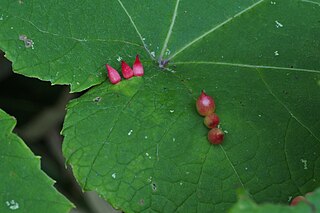
Rhopalomyia is a genus of gall midges, insects in the family Cecidomyiidae. There are at least 267 described species in Rhopalomyia. Most species in this genus induce galls on plants in the Asteraceae. This genus has a cosmopolitan distribution. Rhopalomyia was first established by Ewald Heinrich Rübsaamen in 1892.
Thecodiplosis is a genus of gall midges, insects in the family Cecidomyiidae. There are about six described species in Thecodiplosis.

Celticecis is a genus of hackberry gall midges in the family Cecidomyiidae.
Astictoneura is a genus of gall midges in the family Cecidomyiidae. There are at least two described species in Astictoneura.
Catotricha is a genus of midges in the family Cecidomyiidae. The five described species in Catotricha are found in the holarctic region. This genus was established by British entomologist Frederick Wallace Edwards in 1938.

Asteromyia is a genus of gall midges in the family Cecidomyiidae. There are about nine described species in Asteromyia.
Craneiobia is a genus of gall midges in the family Cecidomyiidae. There are at least two described species in Craneiobia. They create tube-like galls on leaves of Cornus plants.
Cystiphora is a genus of gall midges in the family Cecidomyiidae. There are about seven described species in Cystiphora.
Micromyinae is a subfamily of wood midges, insects in the family Cecidomyiidae. Its members were formerly included in subfamily Lestremiinae. There are at least 55 genera and more than 650 described species in Micromyinae. All species in this subfamily are mycophageous.

Lasioptera is a genus of gall midges in the family Cecidomyiidae. There are at least 140 described species in Lasioptera.

Olpodiplosis is a monotypic genus of gall midges, insects in the family Cecidomyiidae. The only described species is Olpodiplosis helianthi.
Prodiplosis is a genus of gall midges, insects in the family Cecidomyiidae. There are about 11 described species in Prodiplosis.
Acericecis is a genus of gall midges in the family Cecidomyiidae. There are at least three described species in Acericecis.
Stephomyia is a genus of gall midges in the family Cecidomyiidae. There are about seven described species in Stephomyia.
Miastor is a genus of gall midges and wood midges in the family Cecidomyiidae. There are about seven described species in Miastor.
Monarthropalpus is a genus of gall midges in the family Cecidomyiidae. There is at least one described species in Monarthropalpus, M. flavus.
Mycophila is a genus of wood midges, insects in the family Cecidomyiidae. There are seven described species in Mycophila. The genus was established by Ephraim Porter Felt in 1911.
Ampelomyia is a genus of gall midges in the tribe Asphondyliini. It consists of the following four species, all of which form galls on grape plants:
Cretocordylomyia is a genus of wood midges in the family Cecidomyiidae. The one described species - Cretocordylomyia quadriseries - is only known from Canadian amber from the Late Cretaceous collected in Canada near Cedar Lake. This genus was established by American entomologist Raymond J. Gagne in 1977.

Ampelomyia conicocoricis is a species of fly in the family Cecidomyiidae. It induces galls on grape plants in Japan. This is the type species for the genus.






